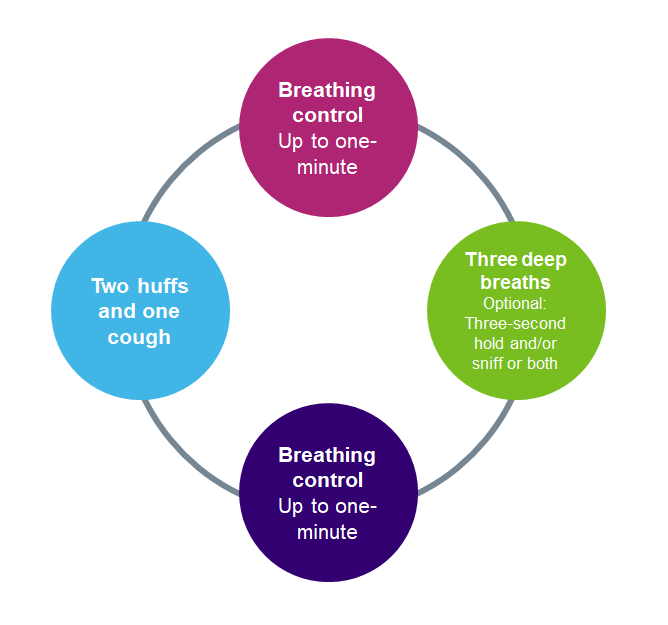Supporting you to recover after COVID-19: Managing your cough and clearing your chest
Last edited: 22/07/2024
Print this page
Share on social media
This content may not be reproduced, without the permission of Kent Community Health NHS Foundation Trust - contact us.
A dry cough is one of the most common reported symptoms of COVID-19, however, in some cases it may be productive of phlegm – a wet or chesty cough. Following COVID-19 you may find that you have a cough and phlegm on your chest.
Dealing with a dry cough
- Stay well hydrated.
- Sip a soft drink (not fizzy) – take small sips, one after the other and avoid taking large sips.
- Use steam inhalation – pour hot water into a bowl and put your head over the bowl. If comfortable, cover your head and bowl with a towel. Do not use boiling water with small children to avoid the risk of scolding.
- Drink warm honey and lemon or another warm drink – this can help to soothe the throat.
- If you do not have a drink to hand, but need to cough, try swallowing repeatedly. This can work in a similar way to sipping water.
Dealing with a productive (wet or chesty) cough
- Stay well hydrated.
- Use steam inhalation – pour hot water into a bowl and put your head over the bowl. If comfortable, cover your head and bowl with a towel. Do not use boiling water with small children to avoid the risk of scolding.
- Try lying on either side, as flat as you can. This can help drain the phlegm.
- Try moving around – this will help to move the phlegm so that you can cough it out.
Exercises to help clear your chest
These exercises and positions can help clear your chest and may be recommended by your physiotherapist or nurse.
The active cycle of breathing technique (ACBT) exercise consists of three breathing exercises which together help clear your chest.
Breathing control
- Breathe in and out gently, through your nose if possible.
- If you breathe out via your mouth, do so through pursed lips.
- Try to take slower breaths.
- Do as many rounds of this as you can and try this technique between other exercises.
Deep breathing
- Take a slow breath in, through your nose if you can.
- Try to breathe out gently, like a long sigh.
- Don’t do any more than three to five deep breaths in a row, as it may make you feel light-headed or dizzy.
- You may find it helpful to hold your breath for two or three seconds before your breathe out.
Small-long huff
This huff is to move phlegm from lower down in your chest or to higher up.
Take a medium breath in and then huff out through an open mouth as though you’re trying to mist up a mirror.
Big-short huff
This huff is to move phlegm from higher up in your lungs. Take a deep breath in and then huff out quickly. This should clear your phlegm without needing to cough.

Active cycle of breathing technique (ACBT) exercise
If huffing doesn’t clear your phlegm, then you may need to cough. Avoid long coughing fits as they can be tiring, give you a sore throat and make you feel breathless.
Clearing your chest should be done regularly. You may only need to do it once or twice a day. If you’re producing more phlegm, you may need shorter but more frequent sessions.
Remember to drink plenty of fluids. This will make it easier to cough up the phlegm.
You may also find our active cycle of breathing technique leaflet helpful.
Positions to help keep your chest clear
Using certain positions along with the active cycle of breathing technique (ACBT) exercise can help clear your chest.
If this symptom is persistent, we recommend being reviewed by a respiratory physiotherapist who can give you advice about postural drainage. Please ask your GP about a referral.
If you have not been assessed by a specialist therapist, please do not attempt this treatment as it could make clearing your airway more difficult if done incorrectly.
Further resources
British Lung Foundation
www.blf.org.uk/support-for-you/coronavirus/how-will-i-recover-if-ive-had-coronavirus
Go to leaflet…
Contact us
This information should only be followed on the advice of a healthcare professional.
Do you have feedback about our health services?
0800 030 4550
Text 07899 903499
Monday to Friday, 8.30am to 4.30pm
kentchft.PALS@nhs.net
kentcht.nhs.uk/PALS
Patient Advice and Liaison Service (PALS)
Kent Community Health NHS Foundation Trust
Trinity House, 110-120 Upper Pemberton
Ashford
Kent
TN25 4AZ
![]()
Donate today, and help the NHS go above and beyond. Visit kentcht.nhs.uk/icare
If you need communication support or this information in another format, please ask a member of staff or contact us using the details above.
